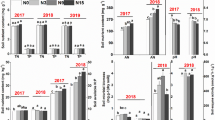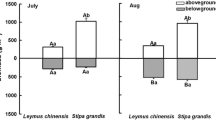Abstract
Nothofagus antarctica forests in south Patagonia are usually used as silvopastoral systems but how grasses and trees compete for specific resources, such as nitrogen in these systems is unknown. To understand interactions between grasses and N. antarctica trees for N, an experiment with 15N labeled fertilizer was carried out comparing N absorption by grasses growing under trees (silvopastoral system) with an open site. Labeled 15NH 154 NO3 fertilizer at 10 % atom excess was added in spring at both sites and 15N was measured in herbage, soil and trees every 30 days during the growing season. Soil was the component that containing the greatest amount of N and greatest 15N recovery. Grasses growing in the silvopastoral system absorbed almost double of the fertilizer applied than grasses in the open site (32.4 kg N ha−1derived from fertilizer based on 15N recovery). Roots were also an important fate for N absorbed, representing 50 and 63 % of total 15N recovered in grass roots of open and silvopastoral sites, respectively. Trees absorbed 69 % less applied N than grasses in the silvopastoral system; being mainly allocated in small branches, sapwood and fine roots. Overall, 15N recovery was 65 % higher in the silvopastoral system (tree + grasses) than in the open site (grasses). Silvopastoral system made more efficient use of the 15N added. These results indicated that N. antarctica trees in the silvopastoral system may “facilitate” fertilizer N absorption of grasses by improving environmental conditions like water availability or by reducing competition for inorganic N between soil microorganisms and plants.


Similar content being viewed by others
References
Aanderud ZT, Bledsoe CS (2009) Preferences for 15N-ammonium, 15N-nitrate, and 15-N glycine differ among dominant exotic and subordinate native grasses from California oak woodland. Environ Exp Bot 65:205–209
Archer S, Boutton TW, Hibbard KA (2001) Trees in grasslands: biogeochemical consequences of woody plant expansion. In: Schulze ED, Schimel D, Prentice IC, Heimann M, Harrison S, Holland E, Lloyd J (eds) Global biogeochemical cycles in the climate system. Academic Press, New York
Axmann H, Sebastianelli A, Arrillaga JL (1990) Sample preparation techniques of biological material for isotope analysis. In: Hardarson G (ed) Use of nuclear techniques in studies of soil-plant relationships. Training course series 2. International Atomic Energy Agency. Vienna, Austria, pp 41–53
Bahamonde H (2012) Efecto de las variables ambientales sobre la producción primaria neta aérea y el contenido de proteína bruta de gramíneas en sistemas silvopastoriles de ñire (Nothofagus antarctica): creación de un modelo de simulación. Tesis para optar al grado de Doctor. Universidad de Buenos Aires
Bahamonde HA, Peri PL, Alvarez R, Barneix A, Moretto A, Martínez Pastur G (2013) Silvopastoral use of Nothofagus antarctica in Southern Patagonian Forest, influence over net nitrogen soil mineralization. Agrofor Syst 87:259–271
Belsky AJ, Mwonga SM, Amundson RG, Duxbury JM, Ali AR (1993) Comparative effects of isolated trees on their undercanopey environments in a highand low rainfall savannas. J Appl Ecol 30:143–155
Bertiller M, Mazzarino MJ (2006) Leaf strategies and soil N across a regional humidity gradient in Patagonia. Oecologia 148(4):612–624
Bertness MD, Callaway RM (1994) Positive interactions in communities. Trends Ecol Evol 9:191–193
Bloom AJ, Chapin FS, Mooney HA (1985) Resource limitation in plants: an economic analogy. Annu Rev Ecol Syst 6:363–392
Buchmann N, Gebauer G, Schulze ED (1996) Partitioning of 15N labelled ammonium and nitrate among soil, litter, below and aboveground biomass of trees and understory in a 15-year-old Picea abies plantation. Biogeochemistry 33:1–23
Callaway RM (1997) Positive interactions in plant communities and the individualistic continuum concept. Oecologia 112:143–149
Callaway RM, Walker LR (1997) Competition and facilitation: a synthetic approach to interactions in plant communities. Ecology 78:1958–1965
Callaway RM, Brookert RW, Choler P, Kikvidezs Z, Lortiek C, Michalet R, Paolini L, Pugnaire FI, Newingham B, Aschehoug ET, Armas C, Kikodze D, Cook BJ (2002) Positive interactions among alpine plants increase with stress. Nature 417:844–848
Carpenter SR (1990) Large-scale perturbations: opportunities for innovation. Ecology 71:2038–2043
Cheng X, Bledsoe CS (2004) Competition for inorganic and organic N by blue oak (Quercus douglasii) seedlings, an annual grass, and soil microorganisms in a pot study. Soil Biol Biochem 36:135–144
Cottenie K, De Meester L (2003) Comments to Oksanen (2001): reconciling Oksanen (2001) and Hulbert (1984) Oikos 395–396
Diehl P, Mazzarino MJ, Funes F, Fontenla S, Gobbi M, Ferrari J (2003) Nutrient conservation strategies in native Andean–Patagonian forest. J Veg Sci 14:63–70
Donoso C, Steinke L, Premoli (2006) Nothofagus antartica. In: Donoso C (ed) Las especies arbóreas de los bosques templados de Chile y Argentina. Autoecología. Marisa Cuneo Ediciones, Valdivia, Chile, pp 401–410
Fernández ME, Gyenge JE, Schlichter TM (2004) Shade acclimatation in the forage grass Festuca pallescens: biomass allocation and foliage orientation. Agrofor Syst 60:159–166
Garrett HE, Kerley MS, Ladyman KP, Walter WD, Godsey LD, Sambeek JW (2004) Hardwood silvopasture management in North America. Agrofor Syst 61:21–33
Goh KM, Mansur I, Mead DJ, Sweet GB (1996) Biological nitrogen fixing capacity and biomass production of different understory pastures in a Pinus radiate-pasture agroforestry system in New Zealand. Agrofor Syst 34:33–49
Holmgren M, Scheffer M, Huston MA (1997) The interplay of facilitation and competition in plant communities. Ecology 78(7):1966–1975
Hsiao TC (1973) Plant responses to water stress. Annu Rev Plant Physiol 24:519–570
Jose S, Guillespie AR, Pallardy SG (2004) Interespecific interactions in temperate agroforestry. Agrofor Syst 61:237–255
Kaye JP, Hart SC (1997) Competition for nitrogen between plants and soil microorganisms. Tree 12(4):139–143
Lawlor DW, Cornic G (2002) Photosynthetic carbon assimilation and associated metabolism in relation to water deficits in higher plants. Plant Cell Environ 25:275–294
Lehmkuhler JW, Kerley MS, Garret HE, Cutter BE, McGraw RL (1999) Comparison of continuous and rotational silvopastoral systems for established walnut plantations in southwest Missouri, USA. Agrofor Syst 44:267–279
Lin CH, McGraw RL, George MF, Garrett HE (2001) Nutritive quality and morphological development under partial shade of some forage species with agroforestry potential. Agrofor Syst 53:269–281
Logan KAB, Thomas RJ (1999) Interactions between N supply and N uptake by perennial ryegrass, 15N recovery and soil pH for four acid Scottish soils. Grass Forage Sci 54:42–51
Ludwig F, Kroon H, Prins HHT, Berendse F (2001) Effects of nutrients and shade on tree-grass interactions in an East African savanna. J Veg Sci 12:579–588
McCarthy MC, Enquist BJ (2007) Consistency between an allometric approach and optimal partitioning theory in global patterns of plant biomass allocation. Funct Ecol 21:713–720
Mokani K, Raison RJ, Prokushkin AA (2006) Critical analysis of root: shoot ratios in terrestrial biomes. Glob Change Biol 12:84–96
Mordelet P, Le Roux X (2006) Tree/grass interactions. In Lamto. Springer, New York, pp 139–161
Muñoz N, Guerri J, Legaz F, Primo-Millo E (1993) Seasonal uptake of 15N—nitrate and distribution of absorbed nitrogen in peach trees. Plant Soil 150:263–269
Nadelhoffer K, Downs MR, Fry B (1999) Sinks for 15N enriched additions to an oak and a red pine plantation. Ecol Appl 9(1):72–86
Neto C, Carranca C, Clemente J, de Varennes A (2008) Nitrogen distribution, remobilization and re-cycling in young orchard of non-bearing ¨Rocha¨ pear trees. Sci Hortic 118(4):299–307
Partala A, Mela T, Esala M, Ketoja E (2001) Plant recovery of 15N labelled nitrogen applied to red canary grass Brown for biomass. Nutr Cycl Agroecosyst 61:273–281
Paruelo JM, Sala OE (1995) Water losses in the patagonian steppe: a modelling approach. Ecology 76(2):510–520
Peri PL, Sturzenbaum MV, Monelos L, Livraghi E, Christiansen R, Moreto A, Mayo JP (2005) Productividad de sistemas silvopastoriles en bosques nativos de ñire (Nothofagus antarctica) de Patagonia Austral. Pp 10 en Actas III Congreso Forestal Argentino y Latinoamericano, Comisión Silvicultura Bosque Nativo. Corrientes, 6 al 9 de Septiembre 2005
Peri PL, Gargaglione V, Pastur Martínez G (2006) Dynamics of above-and below-ground biomass and nutrient accumulation in an age sequence of Nothofagus antarctica forest of Southern Patagonia. For Ecol Manage 233:85–99
Peri PL, Gargaglione V, Pastur Martínez G (2008) Above-and belowground nutrients storage and biomass accumulation in marginal Nothofagus antarctica forests in Southern Patagonia. For Ecol Manage 255:2502–2511
Perry MEL, Schacht WH, Ruark GA, Brandle JR (2009) Tree canopy effects on grass/legume mixture in eastern Nebraska. Agrofor Syst 77:23–35
Rimski-korsakov H, Rubio G, Lavado RS (2012) Fate of the nitrogen from fertilizers in field-grown maize. Nutr Cycl Agroecosyst 93:253–263
Rowe EC, Van Noordwijk M, Suprayogo D, Hairiah K, Giller KE, Cadisch G (2001) Root distributions partially explain 15N uptake patterns in Glaricidia y Peltophorum hedgerow intercropping systems. Plant Soil 235:167–171
Scholes RJ, Archer SR (1997) Tree–grass interactions in savannas. Annu Rev Ecol Syst 28:517–544
Simmons MT, Archer SR, Teague WR, Ansley RJ (2008) Tree (Prosopis glandulosa) effects on grass growth: an experimental assesment of above-and belowground interactions in a temperate savanna. J Arid Environ 72:314–325
Soethe N, Lehmann J, Engels C (2006) The vertical pattern of rooting and nutrient uptake at different altitudes of a south Ecuadorian montane forest. Plant Soil 286:287–299
Treydte AC, Looringh van Beeck FA, Ludwig F, Heitköing IMA (2008) Improved quality of beneath-canopy grass in South African savannas: local and seasonal variation. J Veg Sci 19:663–670
Veblen TT, Donoso C, Kitzberger T, Rebertus AJ (1996) Ecology of southern Chilean and Argentinian Nothofagus forests. In: Veblen T, Hill R, Read J (eds) The Ecology and Biogeography of Nothofagus forests. Yale University Press, New Haven, pp 293–353
Author information
Authors and Affiliations
Corresponding author
Rights and permissions
About this article
Cite this article
Gargaglione, V., Peri, P.L. & Rubio, G. Tree–grass interactions for N in Nothofagus antarctica silvopastoral systems: evidence of facilitation from trees to underneath grasses. Agroforest Syst 88, 779–790 (2014). https://doi.org/10.1007/s10457-014-9724-3
Received:
Accepted:
Published:
Issue Date:
DOI: https://doi.org/10.1007/s10457-014-9724-3




